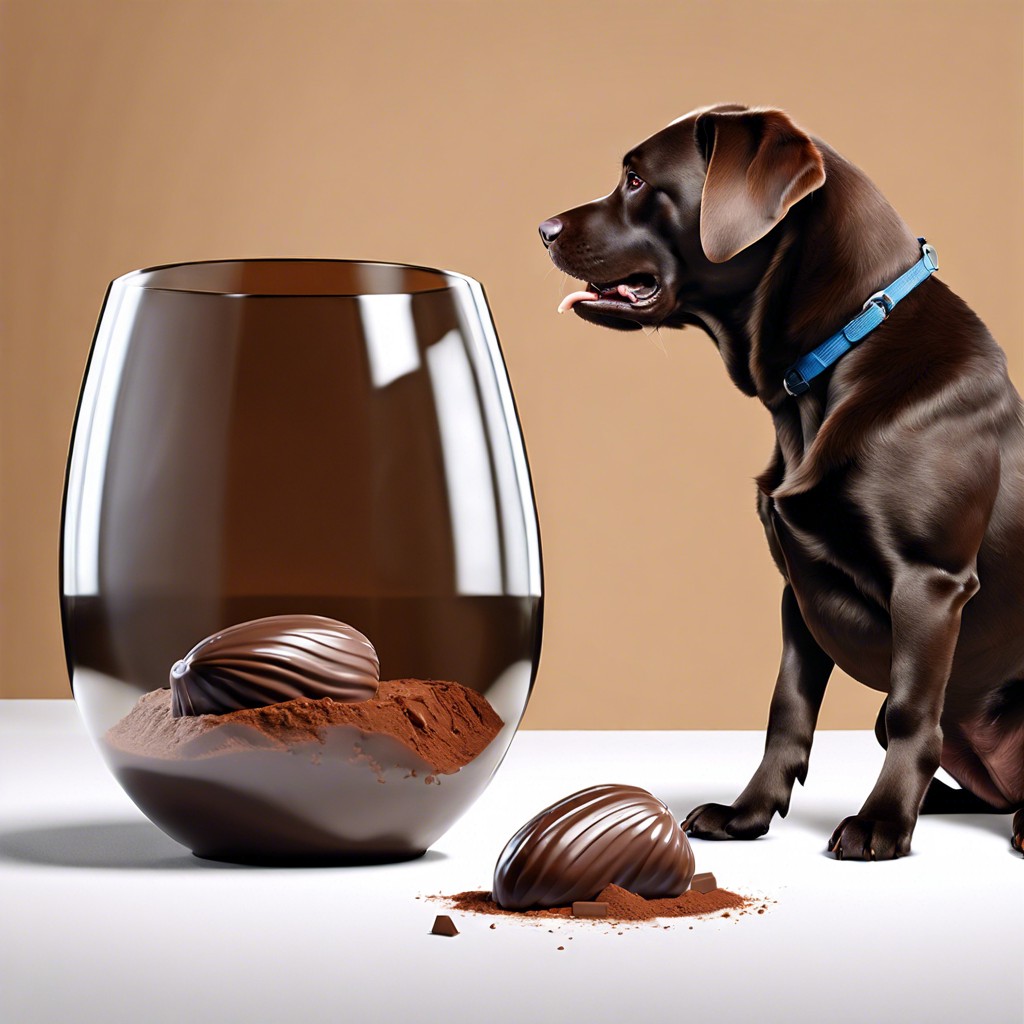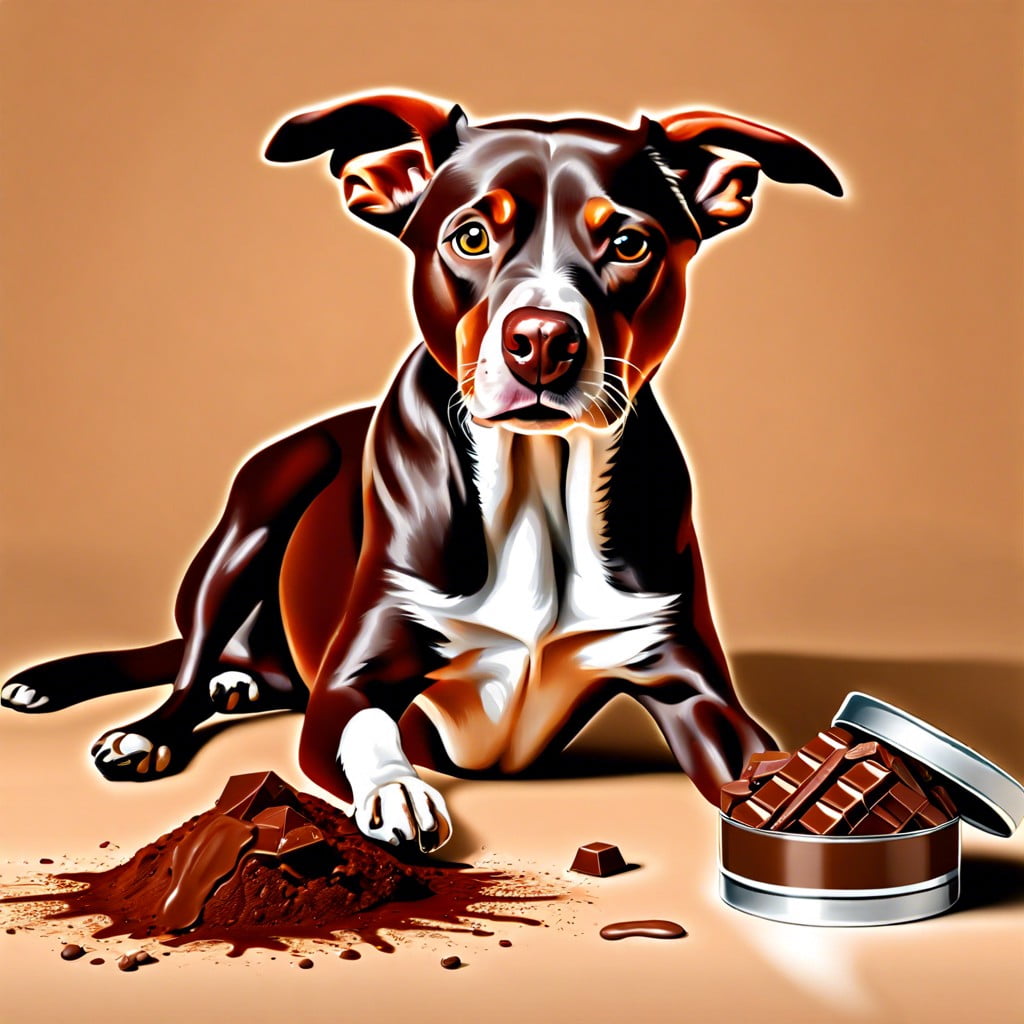Discover why chocolate is toxic to dogs and how to keep your furry friend safe from this common household hazard.
Key takeaways:
- Theobromine and caffeine in chocolate are toxic to dogs.
- Dogs can’t metabolize these compounds effectively, leading to toxic levels.
- Different types of chocolate have varying amounts of theobromine and caffeine.
- Symptoms of chocolate poisoning in dogs include hyperactivity, digestive upset, abnormal heart rhythm, tremors, and seizures.
- If your dog consumes chocolate, seek veterinary assistance immediately and prevent physical activity.
Inside
Theobromine and Caffeine: Toxic Compounds in Chocolate

Chocolate contains two main toxic substances that pose health risks to dogs: theobromine and caffeine. Both are types of methylxanthines, which dogs are unable to metabolize effectively. Theobromine is the most abundant of these, especially in dark and unsweetened chocolate.
While humans can easily process theobromine and caffeine, dogs process these compounds much more slowly, allowing them to build up to toxic levels in their system. These substances affect the central nervous system, cardiovascular system, and act as a diuretic.
The trouble with theobromine is that it can lead to muscle tremors, seizures, and an irregular heartbeat. On the other hand, caffeine, although present in lower amounts in chocolate, can contribute to a dog’s restlessness, heart palpitations, and rapid breathing.
Different types of chocolate contain varying levels of theobromine and caffeine. For instance, white chocolate has the least concentration of these compounds, while cocoa powder and baking chocolate have the highest. Even a small amount of dark chocolate can be dangerous for a small dog.
Understanding the presence of these harmful substances in chocolate highlights why it is essential to keep this sweet treat out of reach of dogs. Even though a dog’s reaction to chocolate can vary according to its size and the chocolate type, it’s best to err on the side of caution and avoid feeding chocolate to dogs entirely.
Clinical Signs of Chocolate Poisoning in Dogs
Dogs experiencing chocolate poisoning typically show signs within six to twelve hours after ingestion. The symptoms can range from mild to severe, depending on the amount of chocolate consumed and the dog’s size.
Initially, a dog may exhibit hyperactivity or restlessness due to the stimulant effects of theobromine and caffeine. Owners might notice an increase in thirst, accompanied by excessive urination, as the body attempts to clear the toxic substances.
Digestive upset often follows, characterized by vomiting and diarrhea, which can lead to dehydration if not addressed promptly. As the condition progresses, more serious signs can develop, including abnormal heart rhythm, tremors, seizures, and in extreme cases, death.
A dog exhibiting any unusual behavior after consuming chocolate warrants immediate attention, as early intervention can be critical for their health. Monitoring for these signs will enable timely action to mitigate the potential dangers of chocolate ingestion.
Immediate Actions to Take If Your Dog Eats Chocolate
If you discover your dog has consumed chocolate, assessing the amount and type of chocolate ingested is crucial. Contact your veterinarian or an emergency pet poison hotline immediately to get assistance. Do not wait for symptoms to appear before seeking help.
While on the phone, provide details such as your dog’s size, the type of chocolate consumed, and the estimated quantity. This information helps to determine the level of toxicity and the need for treatment.
Your vet might instruct you to induce vomiting at home, but only do this if explicitly directed. Do not use salt, mustard, or other home remedies to induce vomiting as they can be harmful.
Keep your dog calm and prevent them from engaging in physical activity which can enhance the absorption of theobromine. Prepare to take your dog to the vet, bringing any remaining chocolate packaging to help the vet assess the situation.
Monitor your dog’s behavior closely for any changes and follow any additional instructions given by your vet. Acting promptly can significantly improve your dog’s outcome after chocolate ingestion.
Veterinary Interventions for Chocolate Ingestion
When a dog ingests chocolate, veterinarians may employ various treatments based on the quantity and type of chocolate consumed, as well as the dog’s size, age, and overall health. Initial treatments often involve inducing vomiting to remove the chocolate from the stomach before more of the theobromine can be absorbed.
If the chocolate was ingested within the last two hours, emetics are administered. Activated charcoal may also be given to prevent further absorption of theobromine into the bloodstream. In severe cases, intravenous fluids may be provided to help stabilize the dog and improve kidney function, aiding in the faster elimination of the toxin.
Medications may be necessary to manage seizures and heart rate abnormalities if they occur. Dogs with signs of severe chocolate poisoning, such as tremors or difficulty breathing, often require hospitalization and continuous monitoring. The prognosis is generally good if prompt and appropriate treatment is administered.
Preventative Measures to Keep Chocolate Away From Dogs
Ensuring that chocolate is stored out of reach is critical for canine safety. Utilize high shelves or cabinets with secure latches to store chocolate and cocoa products. Educate family members, especially children, about the dangers of feeding chocolate to dogs and the importance of keeping sweets inaccessible. During holidays like Easter or Halloween, when chocolate is more prevalent, exercise additional caution and supervise dogs closely in environments where chocolate might be within reach.
Incorporating dog-proof trash cans with locking lids can prevent dogs from scavenging for chocolate or chocolate-containing wrappers. When hosting gatherings, inform guests about the household rule against feeding dogs chocolate to prevent well-meaning individuals from sharing harmful treats.
Consider alternative dog-safe treats to satisfy your pet’s curiosity without posing a risk. Regular training and reinforcement of the “leave it” command can also be a valuable tool in preventing dogs from picking up or eating chocolate they may encounter.




